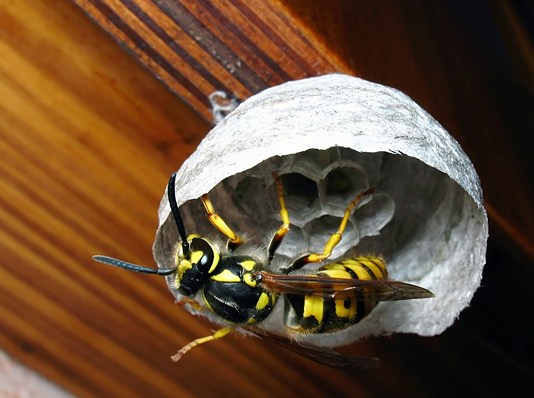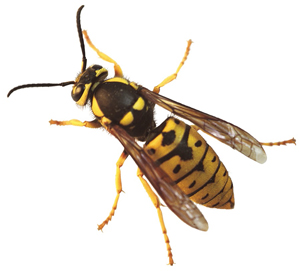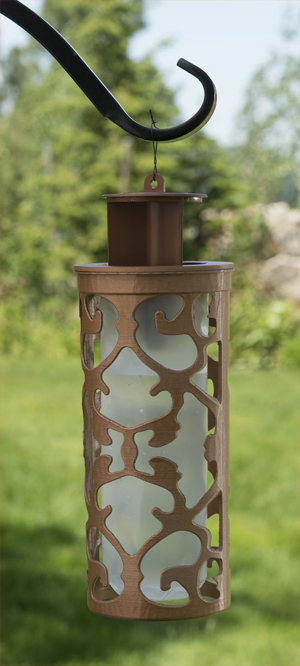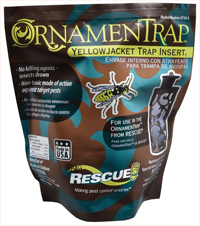






A German yellow jacket queen (Vespula germanica), starting to build a nest. Photo: Rescue pest control
OFTEN confused with bees, yellow jackets are much more aggressive, and most reported "bee stings" may in fact be yellow jacket stings. Here are some of the most commonly asked questions, with answers from Rescue®, maker of the OrnamenTrap® Yellow Jacket Trap.
Related: All About Yellow Jackets, Bees and Their KinWhen is yellow jacket season?
The season begins anywhere from March to May (depending upon the climate) and lasts through September or October. The queens emerge in the first warm days of spring to select a nest site to lay eggs, and the worker population grows to maximum size in late summer and early fall.
What times of year are yellow jackets most likely to sting?
In late summer or early fall, when their nests reach maximum size.

A prairie yellow jacket (Vespula atropilosa) Photo: Rescue pest control
Do yellow jackets serve any beneficial purpose?
Yellow jackets feed on insects, including pest insects, such as houseflies, caterpillars and grasshoppers. Fall webworms and codling moths may be taken as prey by several yellow jacket species.
How do you know if you are allergic to a yellow jacket sting?
Some signs you may be allergic:
If you experience any of these symptoms after a sting, you may be having a life-threatening allergic reaction. Seed medical attention immediately.
How do you treat a yellow jacket sting?
Wash the wound carefully with soap and water. This will help remove the venom. Apply cold water or ice in a wet cloth. Or apply a paste of meat tenderizer with water, which may help neutralize the venom and decrease pain.

OrnamenTrap Yellow Jacket Trap
Do yellow jackets die after they sting?
No. Unlike honeybees, yellow jackets do not lose their stinger, so they can sting numerous times.
Where do yellow jackets make their nests?
Yellow jacket nests are most often built underground. The nest has a single entrance, usually no larger than the size of a nickel. Other locations include wall voids of buildings, hollow trees or logs and attics. There is also a species commonly referred to as the "aerial yellow jacket" which makes nests in trees.
Do yellow jackets keep the same nest year after year?
In most cases, no. The nest decomposes after the season and is not reused. In some warmer climates, however, perennial nests have been found to exist.
I think I have a yellow jacket nest in my yard. What should I do?
We recommend calling a professional pest control operator to remove the nest because of the danger involved. Yellow jackets will vigorously defend their nest if it is disturbed.
If yellow jackets are bothering me, does that mean there is a nest nearby?
Not necessarily. Yellow jackets will travel over 1,000 feet from their nest to forage for food.
What is the difference between yellow jackets and paper wasps?
The yellow and black coloring may appear similar, but paper wasps have more slender abdomens and longer legs that dangle down while they are in flight. Their nests are usually built under eaves, while yellow jackets most often will build their nests in the ground.
The appearance of yellow jacket and paper wasp nests also differs. Paper wasp nests look like honeycombs with multiple openings, while yellow jacket nests have a single opening.
The OrnamenTrap Yellow Jacket Trap is a decorative and pesticide-free way to trap yellow jackets in your outdoor living area. The trap includes one metallic plastic cover and one insert with attractant. Simply add water to the insert and the attractant packet will dissolve and start luring yellow jackets to the trap. The insects enter and can't escape, eventually drowning. Each insert lasts for two to three weeks; refill inserts sold separately. Yellow jacket species vary by region; therefore, we offer two trap (and refill) options. Choose East for areas east of the Rocky Mountains, or West for areas west of the Rocky Mountains.
Where do I place the trap?
Place the trap away from human activity, as yellow jackets will be drawn to the area near the trap. Place where there is air movement, but not strong wind. For best results, it is a good idea to place traps around the perimeter of your property to create a barrier. If you know a nest is nearby, the trap should be placed at least 20 feet away from it.
What is the range of the trap?
The trap should cover a radius of 20 feet. Three to four traps will cover an average-sized yard.
How close to the nest should I place the trap?
The trap should be placed no closer than 20 feet from a yellow jacket nest. (Nests are usually underground, with an opening the size of a nickel.)
How often do I replace the attractant in the trap?
Insert a new refill every two to three weeks. If the attractant dries out (as in very hot temperatures), you may add a few drops of water to the cotton ball to extend the life of the attractant.
Will the trap work without the attractant?
The attractant is the primary lure for drawing yellow jackets to the trap. You can use it with the supplemental attractants we suggest on the package instructions, but food used alone will yield smaller and short-lived catches.
You can enhance the effectiveness of the reusable trap by adding a protein supplement during the summer, in addition to the attractant. We recommend turkey ham because it doesn't spoil and provides the most consistently successful results. Products high in fat content quickly spoil and will actually deter yellow jackets — as will any decayed matter. During the late summer and early fall, a carbohydrate supplement (such as apple juice concentrate) is recommended.
What time of day is it safe to hang or empty the trap?
Evening or early morning are the best times to hang or empty the trap, when there is no yellow jacket activity. We recommend emptying the trap before the dead yellow jackets accumulate above the cone.
How do I empty the trap if there are live yellow jackets inside?
Placing the trap in the freezer for a couple of hours will kill any remaining yellow jackets. Be sure to first tape over the bottom entrance holes.
What is the difference between queen and worker yellow jackets?
Yellow jacket queens can be up to three times larger and wider than the workers. Queens are the first to emerge in the first warm days of spring; at this time, they select a new nest site and lay their eggs. The workers emerge about 30 days later, and the colony attains maximum size — up to 4,000 workers — in August or September. When you use the OrnamenTrap Yellow Jacket Trap in the spring, you can catch several queens and thereby lessen the chance that a yellow jacket nest will be built on or near your property.
If it has been over four hours since you activated your OrnamenTrap Yellow Jacket Trap and it is not attracting yellow jackets, you may have paper wasps rather than yellow jackets. Use a Natural Wasp Deterrent instead.
Can I use the OrnamenTrap Yellow Jacket Trap indoors?
No; the trap is meant to be used outdoors only, to draw the yellow jackets away from human activity. The trap also needs airflow to disperse the attractant.

OrnamenTrap Yellow Jacket Trap Refill
Does the OrnamenTrap Yellow Jacket Trap catch ground hornets or meat bees?
Yellow jackets are sometimes referred to as ground hornets, ground bees or meat bees in different parts of the country. If it's truly a yellow jacket, the OrnamenTrap Yellow Jacket Trap will catch it.
Will honey bees be attracted to the trap?
No, the attractant lures only yellow jackets. Honey bees are regarded as beneficial insects because they pollinate crops and flowers and produce honey.
Copyright © www.100flowers.win Botanic Garden All Rights Reserved